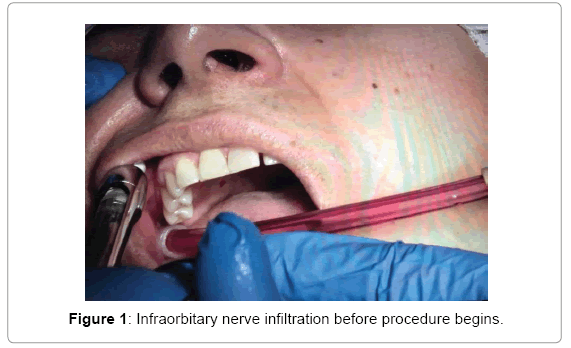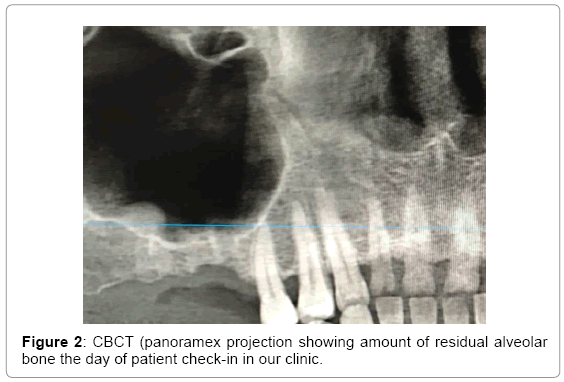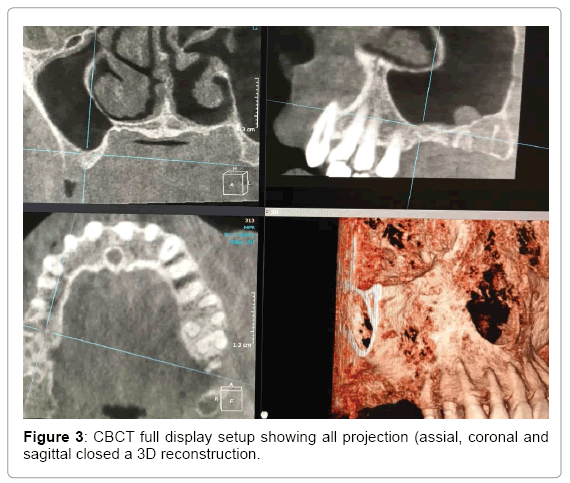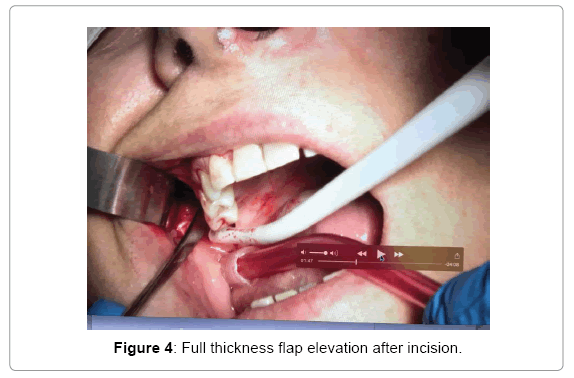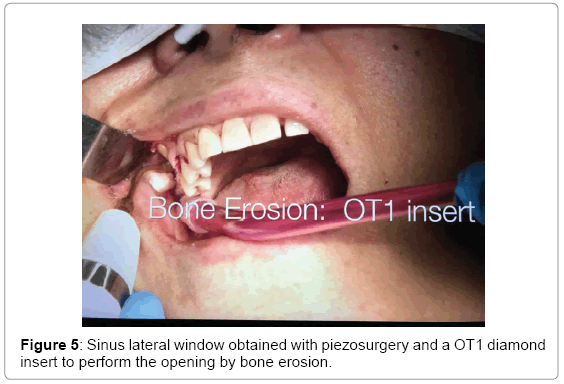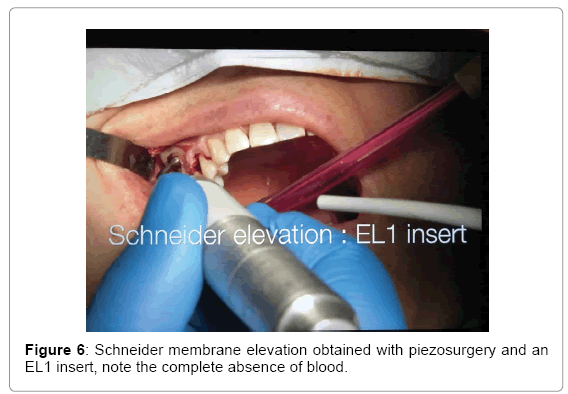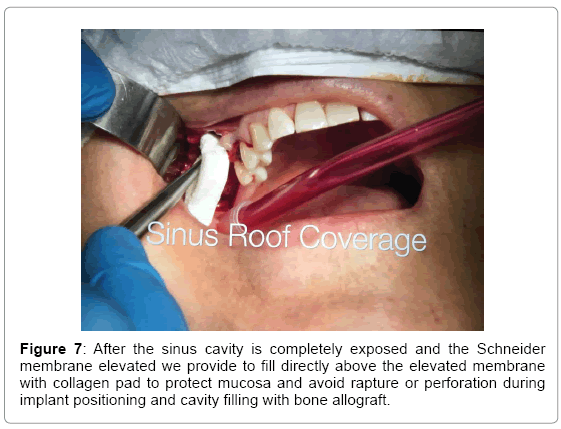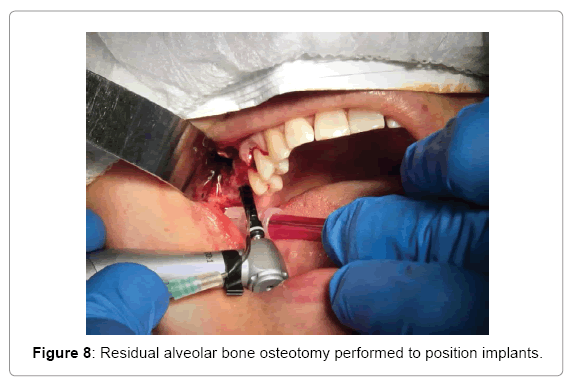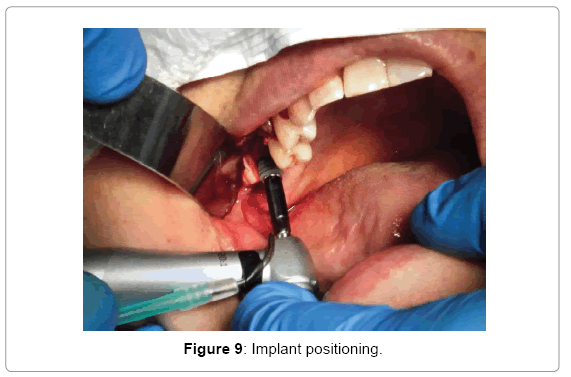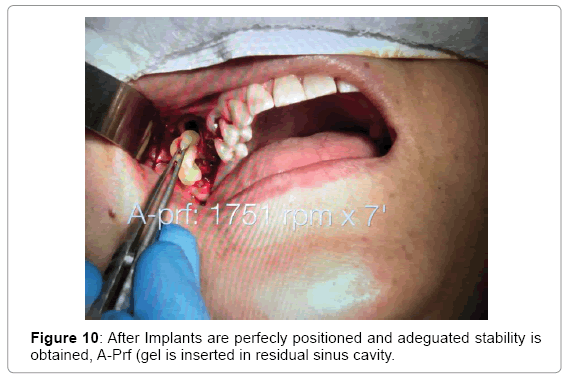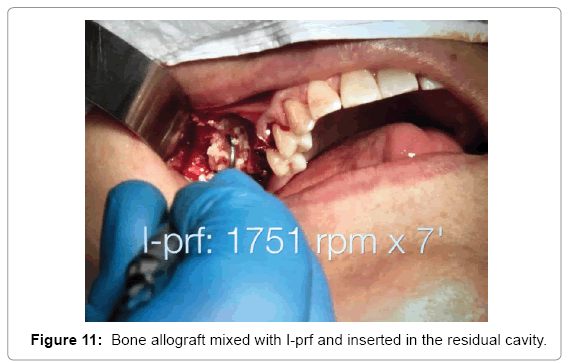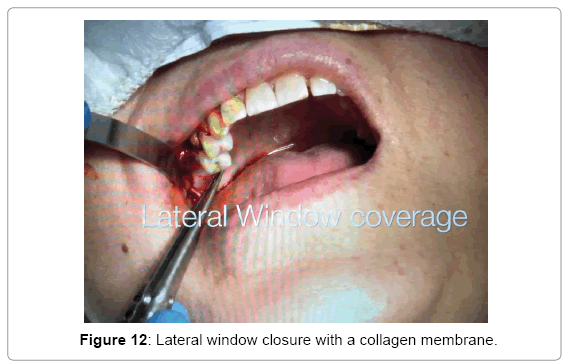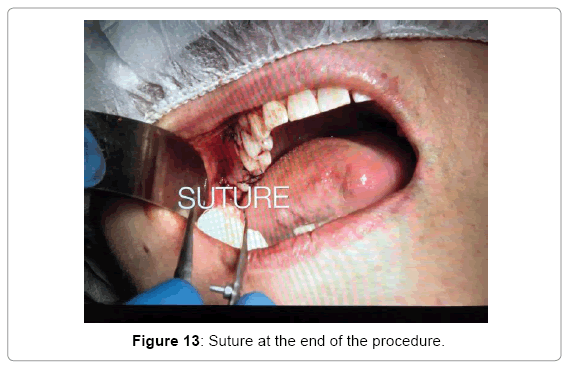Sinus Lift Procedure and Immediate Implant Placing: A Piezo-Surgery and Platelet Rich Plasma Approach: A Case Report
Received: 20-Nov-2017 / Accepted Date: 01-Dec-2017 / Published Date: 08-Dec-2017 DOI: 10.4172/2161-119X.1000335
Abstract
Insufficient bone volume is a common problem occurring during the rehabilitation of the edentulous posterior maxilla with implant supported prostheses. The bone available for implant placement may be limited by the presence of the maxillary sinus together with loss of alveolar bone height and it may be increased by augmentation. This case report presents the rehabilitation of the right maxillary molar region using direct sinus lift followed by immediate placement of two Implants. It helps in reducing the treatment time and increases the patient comfort. Recently, several clinical studies have been performed to evaluate the use of Platelet-rich Plasma (PRP) in maxillary sinus augmentation. Aim of this case report is to evaluate Surgical Procedure of Sinus lifting associated with PRP use and Piezosurgical technique to open the lateral window and to elevate Schneider Membrane before implant positioning and intrasinusal bone augmentation procedures. Our conclusion is that Piezosurgery and Platelet Rich Plasma can make sinus lift procedure safer with a slightly faster recovery time. However it remain a good alternative (worldwide recognized by results) to other procedure only for skilled Practitioner if performed after scheduling a seriously therapeutic Programme. Inclusion criteria, procedural steps and healing time must be strictly observed. Overall, results, encourage us to follow choosen scheme for the future.
Keywords: Immediate implant; Piezoelectric surgery; Platelet rich plasma; Sinus lift
Introduction
Implant prosthesis has become a useful and common treatment for the restoration of missing teeth. However, the implant placement and, consequently, an adeguate functional prosthetic rehabilitation in the maxillary molar region, requires further attention, because of potential bone quality and anatomical structure issues, related to masticatory pattern and occlusal load entity. In the maxillary molar area, the height of alveolar bone may be reduced due to acute or chronic periodontal disease, Sinus pneumatization or atrophy of the residual alveolar ridge after extraction. Thus, implant placement in this area can be difficult or even impossible. Besides, the reabsorption process, in edentulous posterior maxillary regions, could determine insufficient vertical dimensions for the implant positioning, often requiring additional surgical procedural steps. These involve the use of several different techniques: 1) Guided bone regeneration performed using bone substitutes often combined with autologous bone and reabsorbable or not-reabsorbable membranes; 2) Surgical expansion through Le Fort I Osteotomy with interposition of bone grafts; 3) Crestal Approach to sinus lift; 4) Lateral Approach to Sinus lift procedures with the contextual filling of the cavity by means of several graft materials. Among these techniques sinus lift is simple and widely used. Maxillary sinus floor augmentation became a routine preprosthetic treatment in recent years. Sinus floor elevation with autogenous bone grafts and/or bone substitutes is a generally accepted procedure that allows the insertion of implants [1]. The technique of “sinus lift” consists in increasing vertically the alveolar ridge of maxillary posterior area by interposing different types of bone grafts between Schneider sinusal membrane and the floor of the maxillary sinus [2,3]. The procedure is one of the most common preprosthetic surgical procedures performed in dentistry today.
Sinus lift is generally performed using the lateral window or crestal approach. Implants placement may be combined with sinus augmentation as a “one-stage” technique. Alternatively, sinus augmentation may be carried out sometime before implant placement as a “two-stage” technique, which requires an additional surgical stage. Worldwide consensus and guidelines related to sinus Procedure with lateral approach give us some alternatives used in surgical Procedings. First: The use of PiezoSurgery technologies: Providing sinus lateral window Approach by Piezosurgery technique is widely accepted as useful procedure [4,5]. Second: Platelet Rich Plasma proceedings. Equally also PRP technology is widely used as support to promote, shortening and protect first step of wound healing and endosinusal bone regeneration. The PRF as a sole filling material for sinus lift with simultaneous implant placement is a simple technique with promising results. PRF membranes represent an easy and successful method to cover the sinus membrane or osteotomy window [6-10]. Apart from these advantages, PRF allows to avoid the use of membranes and barriers, thus reducing the risk of possible exposure to the oral cavity and of the consequences that the bacterial contamination may have on the regenerative process [7]. The adjunction of PRP allow for a 60 percent reduction of bone graft volume used for sinus floor elevation. The bone obtained with PRP had the same histologic and mechanical characteristics as the bone obtained by traditional graft. The quality of this bone was adapted to dental implant placement [8]. All we know that Sinus lifting with lateral approach is a technique strictly operator-dependent. Experience, a good surgical hand and a well-balanced team, allow you to safely complete a surgical procedure that is universally recognized to be quite difficult. However, if there are technical variations that make the procedures simpler and safer for both operator and patient, it is advisable to take them into account. For that reason we thought to evaluate the efficacy of Piezosurgery and Prp in Sinus Procedure. Our decision become also from the Operator experience both with two techniques matured in several years of study and Surgical Application. If Schneider membrane elevation will be actually safer by Piezosurgery use and the use of PRP in bone augmentation phase and wound healing will be both demonstrated, than we’ll consider such technique as a valuable alternative in conventional procedure during Sinus operating moment.
Materials and Methods
Choice of inclusion criteria
We have established some inclusion criteria to regulate recruitment of patient to treat with Direct sinus procedure. These include: 1) Need of the patient for fixed appliance restoration. 2) Dental and occlusal pattern needs to be appropriate for an equilibrate biomechanics restoration: adeguate vertical dimension, absence of traversal cross-bite condition, preferably mid occlusal fulcrum (not posterior nor anterior) referred to sagittal axis. 3) Time elapsed from teeth loss starting from a minimum of 3 months. 4) Impossibility to apply any other surgical procedure scheme safely. 5) Sinus Anatomy ideal for augmentation technique and possibly absence of intrasinusal septa and/or arterial evidence in the area of active treatment 6) absence of any inflammatory or septic pathology due to Schneider membrane site. 7) Operator personal experience 8) surgical team skilled for sinus surgery [11-15].
History
A female patients aged 45 reported to the office missed upper and lower back teeth and finding of difficulty in chewing. History revealed that teeth was extracted due to periodontal pathology about three months ago and she need a fixed restoration in both upper and lower arch.
Inclusion criteria
On clinical examination teeth #16,#17, #18, #35, #36, #37 were missing opt and cone-beam ct findings showed a bone height insufficient (Figures 1 and 2) x implant placement. Sinus anatomy was judged ideal and there was no findings of active or past Schneider membrane Pathology. Operator and surgical team normally manage sinus lift procedure.
Diagnosis
Loss of an adeguate alveolar bone support in the upper right molar regions for Implant placement. Diagnostic program consist in 1) Alginate Impression recorded for pre surgical diagnostic casts to evaluate prosthetic program. 2) opt and cone beam X-ray assays to evaluate periodontal dental condition and topography of sinus cavity [15-20].
Program
Sinus lift procedure was scheduled with lateral approach to establish an adeguate alveolar bone support with the immediate placement of Implants positioned #16 and #17. Due to anatomy of Sinusal cavity was established a large amount of bone graft should be used, so a I-Prf technique was planned to facilitate bone graft insertion after implant positioning. No X-ray (cbct) evidence of artery vessels was found in the area of Schneider elevation. To protect roof of the elevated membrane a 5 × 5 cm collagen pad was programmed. In addition an A-PRF membrane was scheduled to be inserted between collagen roof protection and I-PRF/bovine bone chips material. Do to operator’s experience, was planned to use Piezo-surgery proceeding to open lateral wall window and Schneider membrane elevation. Treatment plan was discussed with the patient, informed about potential complication for procedure choose. Patient was informed about alternative in prosthetic rehabilitation and an adeguate Informed Consent was taken [21-26].
Preparation of the patient
Adeguate Prophylaxis treatment was begun the day before surgery.
Sinus step: The maxillary posterior segment was anesthetized with buccal and palatal in infiltration using local anesthesia of 2% lignocaine with 1: 100,000 adrenaline. A troncular block of infraorbitary nerve was performed to avoid pain during intrasinusal part of the procedure (Figure 3). Once the patient was anesthetized, an incision was made using #15 surgical blades and extending from the distal surface of canine to the mesial surface of 18. A vertical incision was extended until the end of the buccal vestibule. A full thickness buccal flap was raised (Figure 4) and a bony window was then traced. We decided to choose bone erosion way to open the lateral window of sinus using a Piezosurgery device (Mectron). We used OT1 insert for bone erosion (Figure 5). After a complete bone erosion was performed, we provided the Schneider membrane elevation, first using a Piezosurgery OL5 tip (Figure 6) and finally completed membrane elevation manually by use of appropriate elevators. Once completely elevated the membrane, we tested its integrity by observing mobility during respiratory acts. Then a collagen membrane was used to protect the roof of created sinus cavity (Figure 7).
Implant positioning: An osteotomy was done in the usual way, like suggested in company Operating manual (Figure 8). Multysystem implants were then placed in17 (4.7 mm × 11.5 mm), 16 (4.7 mm × 11.5 mm), tapped in place using the motor driver at 25 rpm and 35 nm torque as reccomended by Multysytem operating manual (Figure 9).
Once the implant seating tip reached the crest of the bone, the implant was properly seated.
Bone regeneration procedures: The remaining space between the implant and sinus floor was again filled with plasma to rinse collagen roof protection, A-PRF (Advanced Platelet-rich Fibrin) gel directly positioned in contact with collagen in the upper section of sinus remodeled cavity (Figure 10). The remaining cavity was filled wit I-PRF ( Injectable Platelet-rich Fibrin) mixed with bone graft (Figure 11) (Ubgen re-bone granules 0.25-1.0 mm of cancellous bovine dried bone particles). This stabilized with the membrane (Biopad Collagen 3 × 4 cm wide and 2 mm thick) to cover lateral window, as shown in the picture (Figure 12). Flaps were approximated and primary sutures were placed using a nylon suture 4-0 (Figure 13). The patient was given postoperative antibiotic and anti-inflammatory coverage. After postoperative instructions were given, the patient was recalled 7 days after surgery for revaluation and suture removal. The control revealed a satisfactory wound healing rate. No signs of sinus pathology due to Surgery was revealed by clinical examination of the patient.
Results
Complete procedure lasted for 1 h and 35 min. No drawbacks occurred during procedure referred to sinus wall opening, Schneider membrane elevation or endosinusal artery recision, PRP use, implant positioning and final closure. Recovery from surgery was quick and unexpected-reaction free. Troncular Anesthesia regress in 3 h. No pain was referred by patient after surgery. A slight edema recurred between 2nd and 4th day. No bleeding episode was referred to suture area. Sinus clinical evidence was silent during healing time; no Rhinorrea occurred. Clinical observation suggest for absence of Schneider membrane compromission. Suture was removed in 7th day ps. No signs infection was found localized in the area of sinus lifting and implants positioning. To Present Implant remained well positioned without signs of bacterial contamination or loss of stability. Regarding Bone augmentation site, to present, 3 months passed from day of surgery. We’ll be able to evaluate results in three to four months [27-31].
Discussion
A sinus lift for implant placement is considered one of the most predictable procedures for augmenting bone in the maxilla. Bone quality of the maxilla is poorer than that of the mandible and, conseguently, atrophy of the alveolar ridge can be more severe in cases of maxillary tooth loss. In addition, maxillary sinus pneumatization may hinder implant placement. To overcome these problems, maxillary sinus lift with an accompanying bone graft represents a simple, widely used procedure. Several approaches have been developed and are currently used. The lateral approach using a Caldwell-Luc osteotomy is historically the first main technique, where the maxillary sinus floor is grafted to provide a sufficient quantity of bone for the placement of dental implants. (Sinus floor elevation with bone augmentation of the maxillary sinus is now well‐accepted procedures which are used to increase bone volume in the posterior maxilla). In this present case, on radiographic examination, the available bone height in the right molar region was found to be only 4.70 mm from the maxillary sinus lining. Since the patient had a missing right molar for few monthes there was Primary atrophy of the edentulous area due to preexisting periodontal pathology and secondary atrophy due to teeth loss. This could have caused continuous loss of bone height and density and an increase in Antral pneumatization. Hence, direct sinus lift using piezosurgical approach, use of PRP technique to promote healing following immediate implant placement was planned. Piezo-surgery technique prevents perforation of the “Schneiderian Membrane” and cause minimal postoperative complications. this compared with conventional procedure with rotative instruments used to open lateral window [31]. Oscillation frequency used in Piezo-surgery is designed for acting only on mineralized tissue; therefore, the cutting tip becomes inactive when it comes in contact with soft tissue. Hence, soft tissue damage is not noticed. In this case, once the bony window was prepared with piezosurgical procedures, osteotomy was widened in #17 and #16 region protecting the raised sinus lining. To stabilize the inserted implants and also to stimulate bone regeneration, gamma irradiated cancellous allograft was used in association with I-PRF (Injectable Platelet-rich fibrin) procedure. This technique has proved to be advantageous not only in reducing the treatment time, but also in preventing infection and allowing a less quantity of cancellous material for grafting procedures.
Conclusion
Clinical experience suggest us that, to provide a good treatment result in sinus lift procedure, depend on a good and serious patient’s evaluation, on inclusion criteria respect and on application of a rigorous technical sequence. Patient selected shows perfectly aligned to inclusion criteria established for sinus procedure. Prosthetic rehabilitation and surgical step program took quite some time. However there were no drawbacks during and after surgery. Piezosurgery revealed usefull for Schneider membrane elevation. However lateral window openinig takes much more time than traditional techniques. At least PS is really safe procedure regard Schneider Membrane preservation. PRP technology needs a medium time fellow to be optimizied for clinical application. Universally recognised as wound healing accelerator and antimicrobical agent, was found in our experience really helpfull as eterologous osteoconductive bone chips carrier (I-PRP). Overall, a good co-worker in sinus Proceding. It Revealed as a non invasive procedure generally well accepted by the Patient..Piezosurgery and Platelet Rich Plasma can make sinus lift procedure safer with a slightly faster recovery time. However it remain a good alternative (worldwide recognized by results) to other procedure only for skilled Practitioner if performed after scheduling a seriously therapeutic Programme. Inclusion criteria, procedural steps and healing time must be strictly observed. Overall, results, encourage us to follow choosen scheme for the future.
References
- Boyne PJ, James RA (1980) Grafting of the maxillary sinus floor with autogenous marrow and bone. J Oral Surg 38: 613-616.
- Jasser RA (2017) An overview of sinus augmentation application. New York State Dental Journal.
- Rickert D, Vissink A, Slater JJ, Meijer HJ, Raghoebar GM (2013) Comparison between conventional and piezoeletric surgical tools for maxillary sinus floor elevation. A randomized controlled surgical trial. Clin Implant Dent Relat Res 15: 297-301.
- Barone A, Santini S, Marconcini S, Giacomelli L, Gherlone E, et al. (2008) Osteotonie and membrane elevation during maxillary sinus augmentation procedure: A comparative study: Piezoelectric devices vs. conventional rotative instruments. Clin Oral Implants Res 19: 511-515.
- Vidhya G, Nesappan T (2016) A piezoelectric study for direct sinus lift with immediate implant placement. J Dent Impl 6: 79-84.
- Ali S, Bakry SA, Abd-Elhakam H (2015) Platelet-rich fibrin in maxillary sinus augmentation: A systematic review. J Oral Implantol 41: 746-753.
- Inchingolo F, Tatullo M, Marrelli M, Inchingolo AM, Scacco S (2010) Trail with platelet-rich fibrin and bio-oss used as grafting material in the treatment of the severe maxillary bone atrophy: Clinical and radiological evaluation. Eur Rev Med Pharmacol Sci 14: 1075-1084.
- Bettega G, Brunn JP, Boutonnat J, Cracowski JL, Quesada JL, et al. (2009) Autologous platelet concentration for bone graft enhancement in sinus lift procedure. Transfusion 49: 779-785.
- Yilmaz S, Karaca EO, Ipci SD, Cakar G, Kuru BE (2013) Radiographic and histologic evaluation of platelet-rich plasma and bovine-derived xenograft combination in bilateral sinus augmentation procedure. Platelets 24: 308-315.
- Aoki N, Kanayama T, Maeda M, Horii K, Miyamoto H, et al. (2016) Sinus augmentation by platelet-rich fibrin alone: A report of two cases with histological examinations. Case Rep Dent.
- Atieh MA, Alsabeeha NH, Tawse-Smith A, Faggion CM Jr, Duncan WJ (2015) Piezoelectric surgery vs. rotatory instruments for lateral maxillary sinus floor elevation: A sistematic revue and meta-analysis and postoperative compilation. Int J Oral Maxfac Impl 30: 1262-1270.
- de Vicente JC, Hernández-Vallejo G, Braña-Abascal P, Peña I (2010) Maxillary sinus augmentation with autologous bone harvested from the lateral maxillary wall combined with bovine-derived hydroxyapatite: Clinical and histologic observations. Clin Oral Implants Res 21: 430-438.
- Rahpeyma A, Khajehahmadi S (2015) Open sinus lift surgery and the importance of preoperative cone-beam computed tomography scan: A review. J Int Oral Health 7: 127-133.
- Stacchi C, Vercellotti T, Toschetti A, Speroni S, Salgarello S (2015) Intraoperative complications during sinus floor elevation using two different ultrasonic approaches: A two-center, randomized, controlled clinical trial. Clin Implant Dent Relat Res 17: 117-125.
- Ferrigno N, Laureti M, Fanali S (2006) Dental implants placement in conjunction with osteotome sinus floor elevation: A 12 year life-table analysis from a prospective study on 588 ITI implants. Clin Oral Implants Res 17: 194-205.
- Balaji SM (2013) Direct v/s indirect sinus lift in maxillary dental implants. Ann Maxillofac Surg 3: 148-153.
- Esposito M, Grusovin MG, Rees J, Karasoulos D, Felice P (2010) Effectiveness of sinus lift procedures for dental implant rehabilitation: A Cochrane systematic review. Eur J Oral Implant 1: 7-26.
- Weitz DS, Geminiani A, Papadimitriou DE, Ercoli C, Caton JG (2014) The incidence of membrane perforation during sinus floor elevation using sonic instruments: A series of 40 cases. Int J Periodontics Restorative Dent 34: 105-112.
- Decker JR, Dutton JM (2013) Local anesthesia for nasal and sinus surgery. Ear Nose Throat J 92: 107-108.
- Hernández-Alfaro F, Torradeflot MM, Marti C (2008) Prevalence and management of Schneiderian membrane perforations during sinus-lift procedures. Clin Oral Implants Res 19: 91-98.
- Ardekian L, Oved-Peleg E, Mactei EE, Peled M (2006) The Clinical significance of sinus membrane perforation during augmentation of the maxcillary sinus. J Oral Maxillofac Surg 64: 277-282.
- Geminiani A, Tsigarida A, Chochlidakis K, Papaspyridakos PV, Feng C, et al. (2017) A meta-analysis of complications during sinus augmentation procedure. Quintessence Int 48: 231-240.
- Merli M (2016) A minimally invasive technique for lateral maxillary sinus lift floor elevation: A Bayesian network study. Clin Oral Impl Resb 27: 273-281.
- Arias-Irimia Ó, Barona Dorado C, Gómez Moreno G, Brinkmann JC, MartÃnez-González JM (2012) Preoperative measurements of the volume of the bone graft in sinus lift using compudent. Clin Oral Implants Res 23: 1070-1074.
- Avila-Ortiz G, Neiva R, Galindo-Moreno P, Rudek I, Benavides E, et al. (2012) Analysis of the influence of residual alveolar bone height on sinus augmentation outcomes. Clin Oral Implants Res 23: 1082-1088.
- Pieri F, Caselli E, Forlivesi C, Corinaldesi G (2016) Rehabilitation of the posterior maxilla using splinted short implants or sinus augmentation with standard length implants: A retrospective cohort study. Int J Oral Maxillofac Implants 31: 1179-1178.
- Aoki N (2016) Sinus augmentation by platelet-rich fibrine alone: A report of two cases with histological examinations. Case Rep Dent.
- Cha HS, Kim A, Nowzari H, Chang HS, Ahn KM (2014) Simoultaneus sinus lift and implant installation: Prospective study of consecutive two hundred seventeen sinus lift and four hundred sixty-two implants. Clin Implant Dent Relat Res 16: 337-347.
- Esposito M, Grusovin MG, Rees J, Karasoulos D, Felice P (2014) Intervention for replacing missing teeth:augmentation procedure of the maxillary sinus. Cochrane Database Syst Rev 17: CD008397.
- Felice P, Scarano A, Pistilli R, Checchi L, Piattelli M (2009) A comparision of two techniques to augment maxillary sinuses using the lateral window approach: Rigid syntetic resorbable barriers versus anorganic bovine bone. Five-month post loading clinical and histological results of a pilot randomised controlled clinical trial. Eur J Oral Implantol 2: 293-306.
- Rosano G, Taschieri S, Gaudy JF, Weinstein T, Del Fabbro M (2011) Maxillary sinus vascular anatomy and its relation to sinus lift surgery. Clin Oral Implants Res 22: 711-715.
Citation: Barbera L, Mat E, Ahmed M (2017) Sinus Lift Procedure and Immediate Implant Placing: A Piezo-Surgery and Platelet Rich Plasma Approach: A Case Report. Otolaryngol (Sunnyvale) 7: 335. DOI: 10.4172/2161-119X.1000335
Copyright: © 2017 Barbera L, et al. This is an open-access article distributed under the terms of the Creative Commons Attribution License, which permits unrestricted use, distribution, and reproduction in any medium, provided the original author and source are credited.
Share This Article
Recommended Journals
Open Access Journals
Article Tools
Article Usage
- Total views: 7305
- [From(publication date): 0-2017 - Apr 03, 2025]
- Breakdown by view type
- HTML page views: 6258
- PDF downloads: 1047

